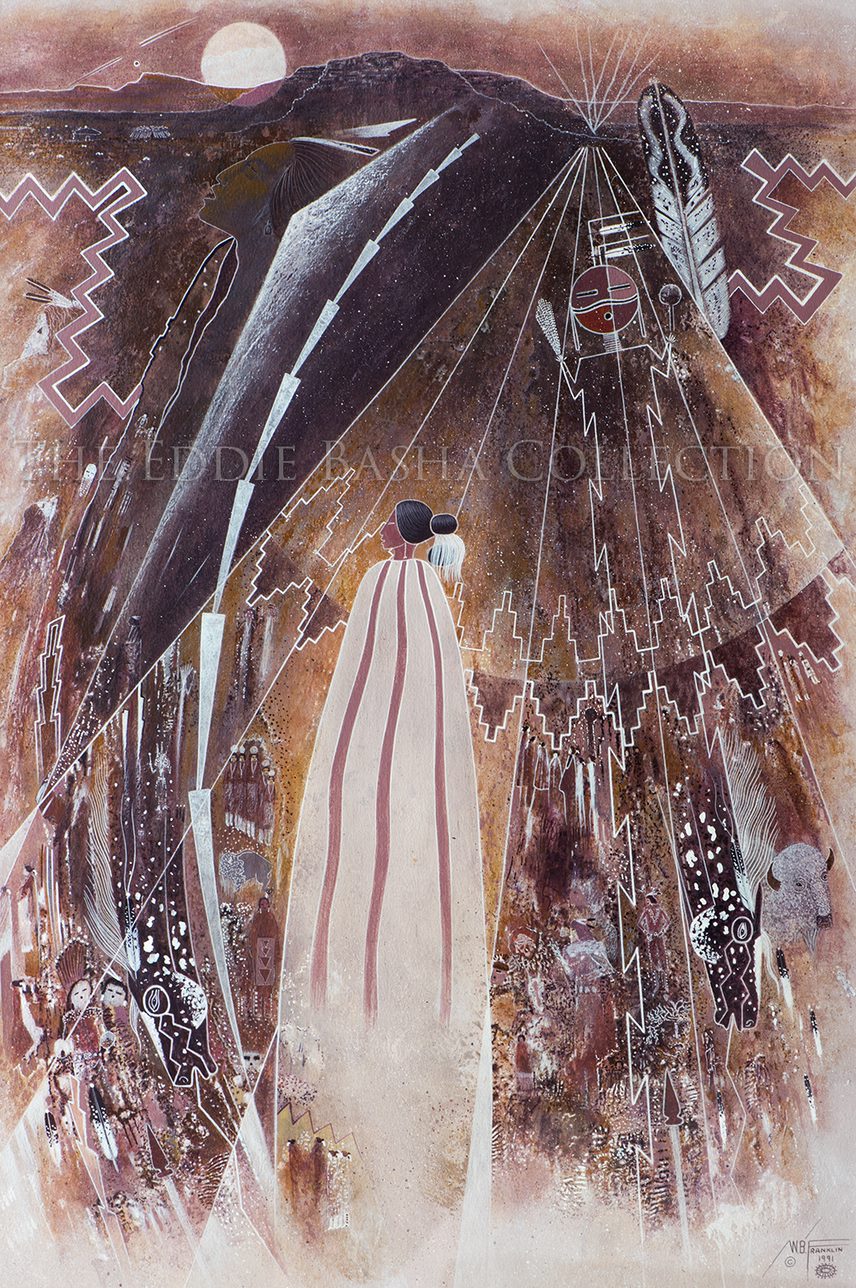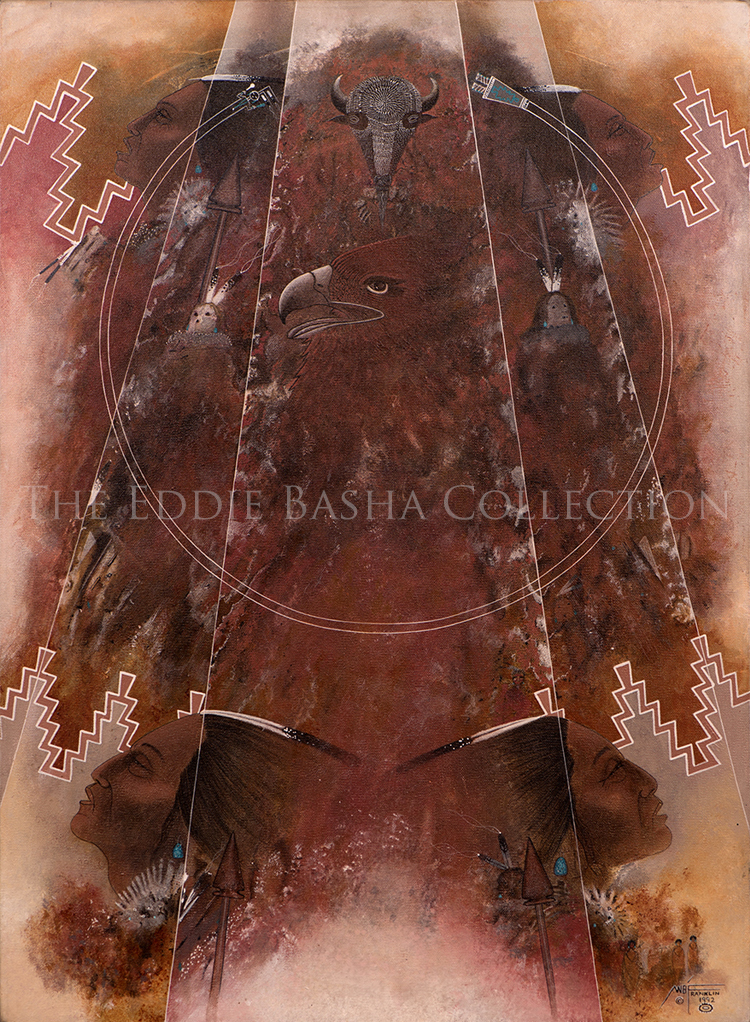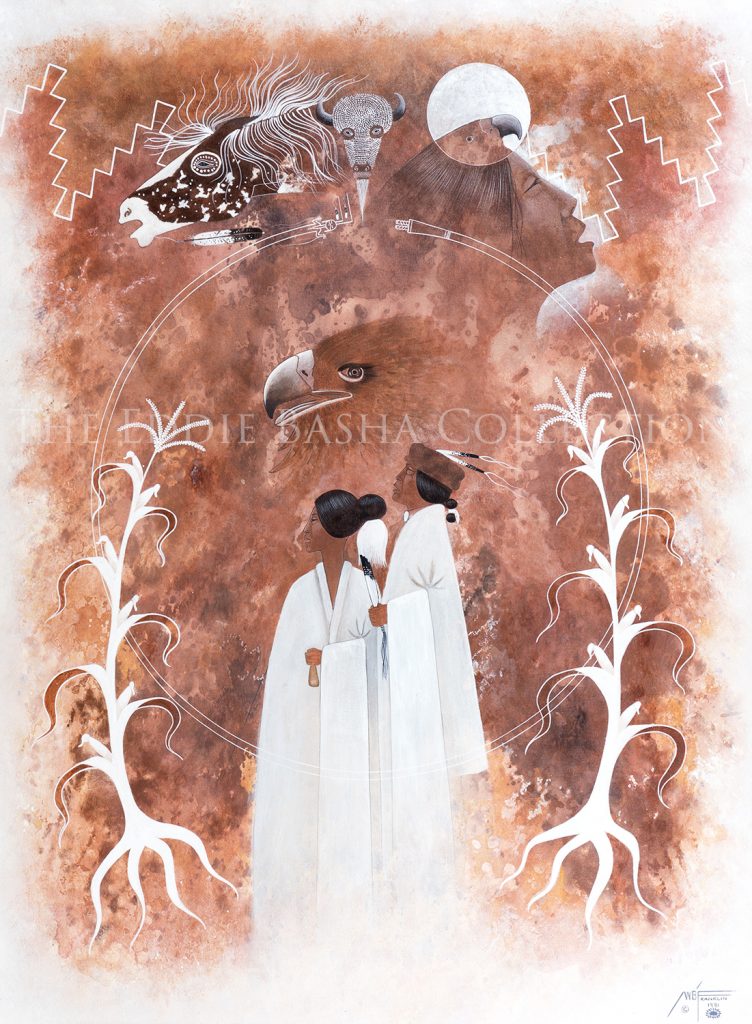
W. B. Franklin
Franklin was born on the Navajo Reservation at Ganado, Arizona, but attended high school in San Francisco and college at the University of Northern Arizona. He is a Sociologist and energy planner by occupation, became a silversmith, and in 1977 switched to paints and canvas. He has been a full-time painter since 1986. He was selected to be the poster artist for the 1994 Indian Market.
Source: Adobe Gallery

Sacred Songs
Artist: W. B. Franklin
Description: Water Soluble (1991) | Image Size: 30”h x 20”w; Framed Size: 37 ½”h x 27 ¾”wpainting
Navajo artist, W.B. Franklin, framed his primary subject in the lower center of the painting in front of a teepee that is situated amid a desert landscape with distant mountains. All are adorned with iconic imagery such as bison, horses, yei, ancestors, a hogan, feathers, arrowheads, a rug, etc. “Sacred Songs” is a cultural homage.
Franklin is a graduate of Northern Arizona University, has won many honors and awards, and his masterworks are in private collections and museums.
Unknown Title
Artist: W. B. Franklin
Description: Water Soluble (1991) | Image Size: 30”h x 22”w; Framed Size: 39 ¼”h x 31 ¼”wpainting
W.B. “Bill” Franklin draws inspiration from the Navajo, or Diné, traditional prayer called “The Beauty Way.”
In beauty I walk
With beauty before me I walk
With beauty behind me I walk
With beauty above me I walk
With beauty around me I walk
It has become beauty again
It has become beauty again
It has become beauty again
It has become beauty again
Surrounded by traditional Navajo imagery, the couple is encircled by a Yei, a spiritual deity, cornstalks before and behind representing its importance as not only a food source but in ceremony as well, a golden eagle immediately above them representing eternal life, above the eagle a horse representing strength as well as healing, a bison that embodies unity, resilience and healthy landscapes and communities, and the matriarchal family figurehead in front of a rising moon with mountains in the distance. In beauty they walk.
Four Songs to the Directions
Artist: W. B. Franklin
Description: Oil (1992) | Image Size: 30”h x 22”w; Unframedpainting
 Water Soluble (1991) | Image Size: 30”h x 20”w; Framed Size: 37 ½”h x 27 ¾”w
Water Soluble (1991) | Image Size: 30”h x 20”w; Framed Size: 37 ½”h x 27 ¾”w Navajo artist, W.B. Franklin, framed his primary subject in the lower center of the painting in front of a teepee that is situated amid a desert landscape with distant mountains. All are adorned with iconic imagery such as bison, horses, yei, ancestors, a hogan, feathers, arrowheads, a rug, etc. “Sacred Songs” is a cultural homage.
Franklin is a graduate of Northern Arizona University, has won many honors and awards, and his masterworks are in private collections and museums.
Sacred Songs
Artist: W. B. Franklin
Description:
Water Soluble (1991) | Image Size: 30”h x 20”w; Framed Size: 37 ½”h x 27 ¾”w
Navajo artist, W.B. Franklin, framed his primary subject in the lower center of the painting in front of a teepee that is situated amid a desert landscape with distant mountains. All are adorned with iconic imagery such as bison, horses, yei, ancestors, a hogan, feathers, arrowheads, a rug, etc. “Sacred Songs” is a cultural homage.
Franklin is a graduate of Northern Arizona University, has won many honors and awards, and his masterworks are in private collections and museums.
paintingNavajo artist, W.B. Franklin, framed his primary subject in the lower center of the painting in front of a teepee that is situated amid a desert landscape with distant mountains. All are adorned with iconic imagery such as bison, horses, yei, ancestors, a hogan, feathers, arrowheads, a rug, etc. “Sacred Songs” is a cultural homage.
Franklin is a graduate of Northern Arizona University, has won many honors and awards, and his masterworks are in private collections and museums.
 Water Soluble (1991) | Image Size: 30”h x 22”w; Framed Size: 39 ¼”h x 31 ¼”w
Water Soluble (1991) | Image Size: 30”h x 22”w; Framed Size: 39 ¼”h x 31 ¼”wW.B. “Bill” Franklin draws inspiration from the Navajo, or Diné, traditional prayer called “The Beauty Way.”
In beauty I walk
With beauty before me I walk
With beauty behind me I walk
With beauty above me I walk
With beauty around me I walk
It has become beauty again
It has become beauty again
It has become beauty again
It has become beauty again
Surrounded by traditional Navajo imagery, the couple is encircled by a Yei, a spiritual deity, cornstalks before and behind representing its importance as not only a food source but in ceremony as well, a golden eagle immediately above them representing eternal life, above the eagle a horse representing strength as well as healing, a bison that embodies unity, resilience and healthy landscapes and communities, and the matriarchal family figurehead in front of a rising moon with mountains in the distance. In beauty they walk.
Unknown Title
Artist: W. B. Franklin
Description:
Water Soluble (1991) | Image Size: 30”h x 22”w; Framed Size: 39 ¼”h x 31 ¼”w
W.B. “Bill” Franklin draws inspiration from the Navajo, or Diné, traditional prayer called “The Beauty Way.”
In beauty I walk
With beauty before me I walk
With beauty behind me I walk
With beauty above me I walk
With beauty around me I walk
It has become beauty again
It has become beauty again
It has become beauty again
It has become beauty again
Surrounded by traditional Navajo imagery, the couple is encircled by a Yei, a spiritual deity, cornstalks before and behind representing its importance as not only a food source but in ceremony as well, a golden eagle immediately above them representing eternal life, above the eagle a horse representing strength as well as healing, a bison that embodies unity, resilience and healthy landscapes and communities, and the matriarchal family figurehead in front of a rising moon with mountains in the distance. In beauty they walk.
paintingW.B. “Bill” Franklin draws inspiration from the Navajo, or Diné, traditional prayer called “The Beauty Way.”
In beauty I walk
With beauty before me I walk
With beauty behind me I walk
With beauty above me I walk
With beauty around me I walk
It has become beauty again
It has become beauty again
It has become beauty again
It has become beauty again
Surrounded by traditional Navajo imagery, the couple is encircled by a Yei, a spiritual deity, cornstalks before and behind representing its importance as not only a food source but in ceremony as well, a golden eagle immediately above them representing eternal life, above the eagle a horse representing strength as well as healing, a bison that embodies unity, resilience and healthy landscapes and communities, and the matriarchal family figurehead in front of a rising moon with mountains in the distance. In beauty they walk.